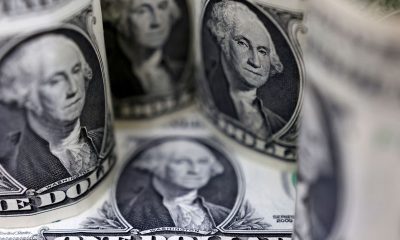Cryptocurrency
Saudi Arabia looks to blockchain gaming and Web3 to diversify economy

Saudi Arabia has ramped up its economic diversification efforts driven by its ambitious Vision 2030.
In a bid to diversify its economy away from a dependence on oil, the kingdom has embraced emerging technologies, such as blockchain and artificial intelligence (AI), and tapped into booming markets like gaming.
But while the country has yet to leave a significant mark in the global game and AI development, the ripples of its investments in the gaming sector could extend far beyond — at least, that’s what Web3 experts say.
“Based on our work and communications that we have, Saudi [Arabia] is very, very interested in Web3,” Animoca Brands co-founder Yat Siu told Cointelegraph.
Given the kingdom’s partnerships with entities such as The Sandbox and even Animoca, Siu sees that there’s an effort from Saudi to venture into the new iteration of the internet. The executive said:
“I think Saudi [Arabia] understands the principle that Web3 gaming or blockchain gaming — the one that we actually prove the owner assets — is going to be the future of gaming.”
Thanks to the interest of its young, tech-savvy population, Saudi Arabia, along with the United Arab Emirates, is driving the growth of the Middle East’s gaming market. According to a Boston Consulting Group report, the kingdom represents 45% of the sector in the region, with a value of more than $1.8 billion. It also boasts one of the largest game revenues in the area, according to game content studio Allcorrect.
In 2017, the kingdom established the Saudi Esports Federation to regulate and develop the country’s gaming industry.
Recent: Ron DeSantis’ falling polls: Could crypto lose its candidate?
Bloomberg reported in April that Saudi Arabia, through its Public Investment Fund, invested $38 billion in the sector as it looks to become a global gaming hub.
Although the Saudi government understands the “high-level concept” of Web3, its potential, and how it can align with esports — where teams can own stakes in games they play — Siu said it remains unclear what its integrations to gaming would be due to the absence of clear rules on cryptocurrency and other virtual assets:
“Cryptocurrency is something that is still to be explored. It’s being investigated. I think [Saudi Arabia is] quite forward about how to deal with it. But they haven’t come up with anything yet.”
“In places like Hong Kong, Japan and the UAE, there’s much more clarity as to what you can do with crypto and Web3. You can map out a strategy,” Siu added.
While it remains to be seen what Saudi Arabia’s Web3 gaming applications would look like, Siu noted that the kingdom is looking at other markets and learning.
“That’s why they’re talking to us. Because they want to know what the best practices are and how they can learn,” the executive explained. “There are very few places in the world that we’ve seen such a hunger and desire to sort of be at the cutting edge.”
“You can feel sort of the desire to have progress and to lead in Saudi Arabia. I think that’s kind of unique,” Siu added.
How gaming can spur Web3 adoption
While pushback from the traditional gaming community and developers persists, Siu claims a successful conversion of users into Web3, whether it’s in gaming or not, should come with financial literacy.
“You can’t really be a true Web3 user if you don’t have at least a certain level of financial literacy that goes above and beyond having a bank account,” Siu said.

The Animoca co-founder claimed that most Web2 users are not capital investors because they’re mostly labor people compared to Web3 people who understand investing.
“What we found is that the path to Web3 mass adoption isn’t giving [Web2 users] just a wallet. That’s actually the easiest part. The harder part is how to make them aware that what they now have is an asset that has potential value, and it could do things and has different network effects that need to be maintained as real value.”
Meanwhile, Mythical Games CEO John Linden told Cointelegraph that he already sees Web3 adoption in the gaming sector, albeit at a slower pace.
“I think we’re seeing some [adoption] already. We’re seeing people that they’re introducing the [Web3] concept. They do understand the concept of buying and selling assets,” Linden said.
Magazine: NFT collapse and monster egos feature in new Murakami exhibition
The gaming industry veteran pointed out that Web3 should enhance user experience and not just give them the means to generate income:
“[Web3 gaming developers] have to focus on new game models. When you start doing that, it introduces creator economy, digital supply chain, ownership of guilds and the ability to come up with your own theory within the game itself.”
“Those are principles I think gamers will attach to,” Linden added.
The Mythical Games CEO projects that the Web3 gaming segment could onboard 50 to 100 million players in the next two years, with their own titles targeting 10 million by the end of 2023.
Cryptocurrency
Ripple (XRP) Price Explosion, Shiba Inu’s (SHIB) Potential, and More: Bits Recap July 18

TL;DR
- XRP surged by 60% in the last month, hitting a new historic peak. Analysts predict further gains, with targets up to $10.
- SHIB rose 30% in two weeks, yet 45% of holders remain in the red. Market observers see more upside based on certain chart patterns.
- BTC dipped to $119K after peaking at $123K, but strong ETF inflows and whale activity suggest the bull run may continue.
XRP Reached Uncharted Territory
Ripple’s XRP has been on the crest of the wave recently, with its price tapping an all-time high (on most exchanges and data aggregators) of over $3.60. The asset’s investors had to wait more than seven years for this achievement since the previous peak of approximately $3.40 was registered at the start of 2018.
Meanwhile, XRP’s market capitalization surged well above $200 billion, solidifying the token as the third-largest cryptocurrency and widening the gap with the fourth, Tether’s USDT.
The coin’s massive rally appears to be a combination of multiple bullish factors, including rising public interest, growing network growth, whales’ accumulation, and the recent green light on some important crypto bills in the United States.
Unsurprisingly, crypto X is rammed with users expecting the uptrend to continue in the short term. Ali Martinez believes a weekly close above $3 could open the door for a price ascent to as high as $4.80. Others like Javon Marks were even more bullish, envisioning a rise to the major milestone of $10.
What’s Going on With SHIB?
The second-largest meme coin experienced a 30% price increase over the last two weeks, while its market capitalization briefly exceeded $9 billion.
However, many of its holders await more substantial gains as they remain in the red. Earlier this week, the percentage of SHIB investors sitting on unrealized losses was around 54%, while currently it is 45%. This is so because a lot of holders joined the ecosystem years ago when Shiba Inu’s price was in much better condition.
Still, numerous analysts think the meme coin has the potential to pump much more significantly during this bull cycle. X user CJ claimed SHIB has formed “a pretty epic structure” on its price chart and predicted a massive jump in the near term.
Is BTC Ready for More?
While the leading cryptocurrency exploded to an all-time high of approximately $123,000 on July 14, it cooled off slightly in the following days. As of this writing, it trades at around $119,000, but certain indicators suggest the rally is far from being over.
BTC’s Market Value to Realized Value (MVRV), for instance, currently stands at around 2.36. “Historically, values over 3.7 indicated price top and values below 1 indicated price bottom,” CryptoQuant explained.
The flow of capital toward spot BTC ETFs remains solid, showing huge interest from investors, while the whales’ accumulation efforts can also be added to the bullish factors.
Binance Free $600 (CryptoPotato Exclusive): Use this link to register a new account and receive $600 exclusive welcome offer on Binance (full details).
LIMITED OFFER for CryptoPotato readers at Bybit: Use this link to register and open a $500 FREE position on any coin!
Cryptocurrency
Stellar Surges 61% Weekly, Peter Brandt Calls XLM the ‘Most Bullish’ Chart

TL;DR
- XLM climbs 61% in seven days, nearing key resistance after strong technical breakout signals.
- Peter Brandt calls XLM the “most bullish chart,” eyes $1 breakout to confirm a multi-year pattern.
- Franklin Templeton tokenizes $446M in U.S. Treasuries on Stellar blockchain, boosting confidence.
Brandt Eyes Breakout Above $1
Stellar (XLM) has gained over 60% in the past week, with the price reaching $0.48 at press time. It is up nearly 5% in the last 24 hours, backed by a 24-hour trading volume of $2.1 billion. The rally has drawn fresh attention after market veteran Peter Brandt described the XLM chart as “potentially the most bullish chart of all.”
Brandt stated that XLM must hold above its April 2025 low near $0.22 and “must must close decisively above $1” to confirm the setup. Until that happens, he said, the chart “will remain range bound.”
Potentially the most bullish chart of all belongs to $XLM
XLM MUST MUST remain above Apr low and MUST MUST close decisively above $1. Until then this chart will remain range bound pic.twitter.com/NZvKLp5SVW— Peter Brandt (@PeterLBrandt) July 17, 2025
Price Structure Builds Toward Key Resistance
Notably, the long-term chart shows a potential ascending triangle along with a cup-and-handle pattern. Both patterns are forming below long-standing resistance at the $1.00 level. That resistance has been tested multiple times since 2018 but has not yet been broken on a closing basis.
XLM’s price is trading above both the 8-period and 18-period moving averages. The shorter-term average has crossed above the longer one, which often signals rising momentum. The ADX is at 45.16, showing that trend strength is elevated.
A short-term resistance area sits near $0.58, according to market analyst CW.
“$XLM is heading towards the sell wall at $0.58. Below that, there is support from the buy wall,” they said.
Stellar Network Sees Institutional Growth
Franklin Templeton recently tokenized $446 million in U.S. Treasuries on the Stellar network. This reflects continued use of the blockchain platform for real-world asset settlement.
In addition, the Stellar Development Foundation also announced new executive hires. José Fernández da Ponte, who previously led blockchain efforts at PayPal, has joined as President and Chief Growth Officer. Jason Karsh, who held roles at Blockchain.com and Coinbase, is now Chief Marketing Officer.
Stellar’s Protocol 23 is set for a mainnet vote on August 14, 2025. The proposal focuses on updates to core features. Ahead of the vote, interest in XLM has increased, with users and developers watching the outcome closely.
Binance Free $600 (CryptoPotato Exclusive): Use this link to register a new account and receive $600 exclusive welcome offer on Binance (full details).
LIMITED OFFER for CryptoPotato readers at Bybit: Use this link to register and open a $500 FREE position on any coin!
Cryptocurrency
Cardano (ADA) Bulls Target $1.31 After Surpassing $0.85 Mark

TL;DR
- ADA breaks resistance at $0.74 and tests $0.85 as bulls push toward higher price levels.
- Analysts eye $1.18 and $1.31 targets if ADA closes daily above the $0.85 breakout level.
- Open Interest on ADA hits $1.65 billion, setting a new record and showing rising trader confidence.
Cardano Holds Gains Near $0.85 After Breakout
Cardano (ADA) traded at $0.852 after rising 7% in 24 hours and 20% over the week. The move followed a breakout from a long downward trend, with buyers now pushing into higher price zones.
Earlier resistance around $0.74 had held the price in check during multiple attempts this year. That level has now been breached. ADA touched nearly $0.78 last week before a brief pullback, but buyers stepped in again, pushing the price above $0.84 heading into the weekend.
Analysts Watch the $0.85 Level for Confirmation
Crypto analyst Ali Martinez said a daily close above $0.85 could open the way toward $1.31. His view is based on earlier market structure and current momentum. ADA has cleared the $0.68 mark, which may now serve as support if prices remain above it.
A daily close above $0.85 could propel Cardano $ADA toward the next key resistance at $1.31! pic.twitter.com/RVgw3yE9lr
— Ali (@ali_charts) July 17, 2025
Marcus Corvinus noted that ADA has exited a long-term descending channel and flagged $0.77 to $0.82 as the next zone to watch. He added that holding above $0.82 could shift attention to $1.18. On the downside, $0.68 and $0.58 are the nearest support zones in case of any pullback.
Open Interest Pushes Higher With Price
Cardano’s recent gains are backed by rising interest in its futures market. Data from CoinGlass shows Open Interest (OI) on ADA has grown by 16% in the last 24 hours, reaching $1.65 billion, surpassing the previous record high of $1.50 billion set on January 18.
Open Interest reflects capital tied to active trading positions. A steady rise often means traders are committing more capital, which can support ongoing moves. This increase adds weight to the recent price trend.
In fact, with ADA reclaiming the $0.80 range and testing $0.85, traders are focused on whether it can close the day above that level.
Binance Free $600 (CryptoPotato Exclusive): Use this link to register a new account and receive $600 exclusive welcome offer on Binance (full details).
LIMITED OFFER for CryptoPotato readers at Bybit: Use this link to register and open a $500 FREE position on any coin!

 Forex3 years ago
Forex3 years agoForex Today: the dollar is gaining strength amid gloomy sentiment at the start of the Fed’s week

 Forex3 years ago
Forex3 years agoUnbiased review of Pocket Option broker

 Forex3 years ago
Forex3 years agoDollar to pound sterling exchange rate today: Pound plummeted to its lowest since 1985

 Forex3 years ago
Forex3 years agoHow is the Australian dollar doing today?

 Cryptocurrency3 years ago
Cryptocurrency3 years agoWhat happened in the crypto market – current events today

 World3 years ago
World3 years agoWhy are modern video games an art form?

 Commodities3 years ago
Commodities3 years agoCopper continues to fall in price on expectations of lower demand in China

 Economy3 years ago
Economy3 years agoCrude oil tankers double in price due to EU anti-Russian sanctions



























